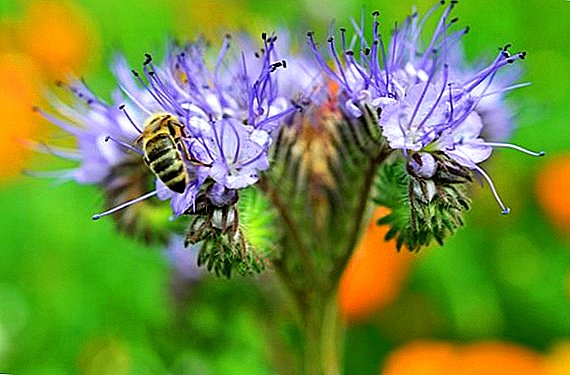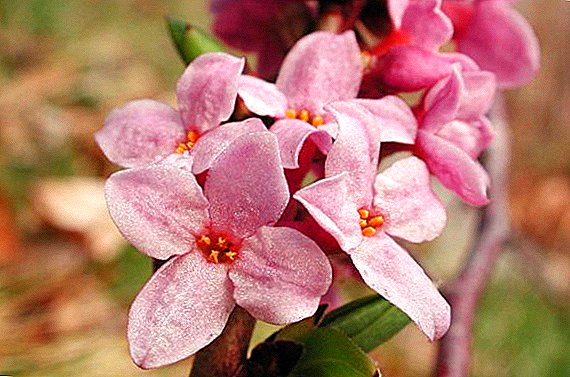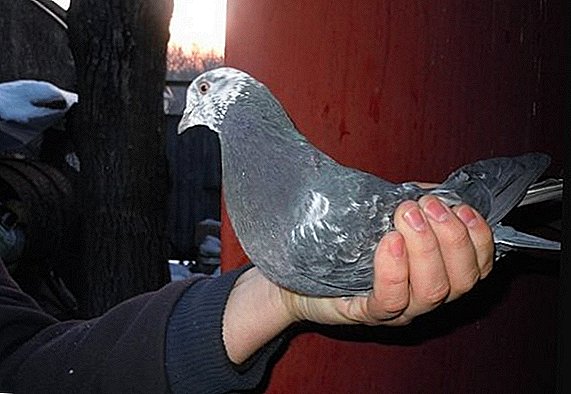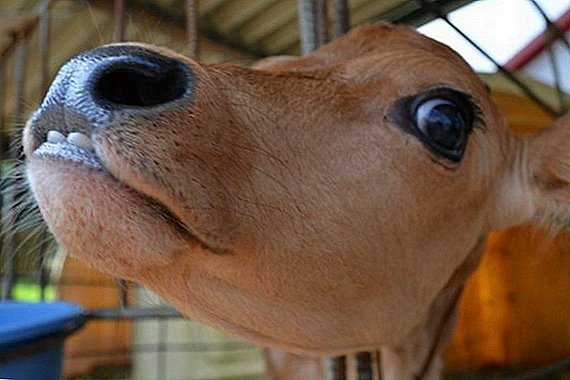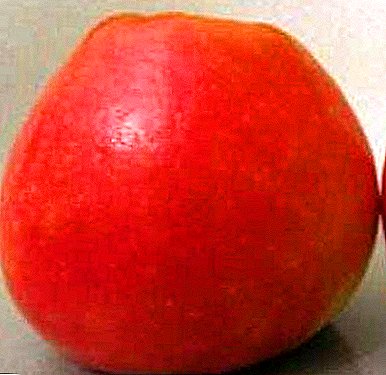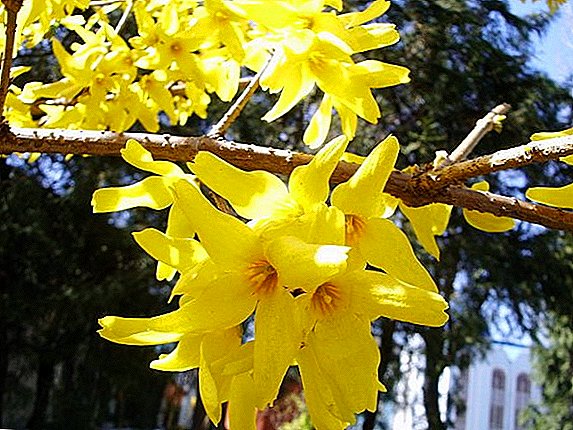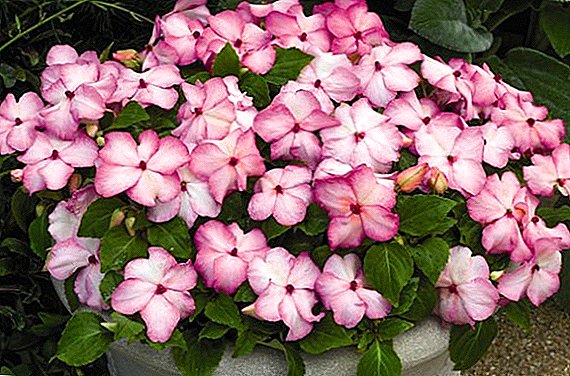 Balsam Waller can often be found both on the windowsill and in the front garden. He is also sometimes called touchy, because with a slight touch or a light breeze, he starts shooting with seed boxes. This article will discuss how to properly grow and propagate this flower, as well as about the features of caring for it.
Balsam Waller can often be found both on the windowsill and in the front garden. He is also sometimes called touchy, because with a slight touch or a light breeze, he starts shooting with seed boxes. This article will discuss how to properly grow and propagate this flower, as well as about the features of caring for it.
Botanical description
Balsam is a herbaceous perennial plant, whose height ranges from 15 to 60 cm. It is rightly considered one of the representatives of the most long-flowering plants that can decorate both the house and the terrace or the plot in the garden.
Balsam Waller belongs to the perennial family, but can manifest itself as an annual. If the flower is grown as a houseplant, it is a perennial. However, in gardening, it behaves like an annual plant, since winter frosts are not able to endure.
Did you know? Among the people, Waller's balsam is also called Vanka wet, since small droplets of moisture are formed on the tips of the leaves, or a spark because of bright colors.

The shape of the balsam bush can be upright, spherical, creeping on the ground or spreading, it depends on the variety. The plant has a thick well-branched stem.
Its color can vary from light green to purple. At the end of the stem are simple or double flowers, which can grow in inflorescences in several pieces, or alone.
Coloring colors depending on the variety can consist of up to 17 different shades. There are flowers with shades of red, white, pink, varieties with a two-tone color, interspersed or spotted in the center of the flower, as well as with motley petals.
Walser balsam is a fairly tall plant (up to 60 cm in room conditions). The foliage of this flower grows alternately and has a red central vein. The shape of the leaves can be lanceolate, whole or tooth parts.  On the edge of the leaf are collected droplets of sweet juice that attract ants. Flowers come in various shapes (complex and simple), and their size varies from 2 to 6 cm in diameter. The buds are predominantly pink, but the hybrids may have different colors.
On the edge of the leaf are collected droplets of sweet juice that attract ants. Flowers come in various shapes (complex and simple), and their size varies from 2 to 6 cm in diameter. The buds are predominantly pink, but the hybrids may have different colors.
The plant has a strong root system, and in individual varieties of roots are collected in a single node. Although Walley's impatiens is a representative of tall plants, some series of varieties do not exceed 30 cm in height.
Plants such as Babian, Adonis, Levkokorina, Crinum, Rhodohypoxis, Pentas, Dodecateon, Sparaxis, Scevola, Sidealcea, Gloriosa, Agapanthus, Penstemon, Lavater, Armeria, Clove Peary and Chionodox also fill your garden with bright colors.
After the Waller balsam fades, a fruit is formed, which is a seed box with many seeds. It has 5 leaflets that open during ripening. 
Distribution and habitat
Zanzibar is considered to be the birthplace of Waller's balsam. This plant is also called Impatiens sultanii. It received such a name in honor of the ruler of Zanzibar, who ruled in the middle of the XIX century (it was during this period that this species was discovered). The most common balsam Waller received in countries with warm climates. It is also popular in places with a temperate climate.
Did you know? The decoration of space with green plantings was very popular at the courts of Eastern rulers for a long time. In Europe, the same practice has spread in the Renaissance.
Use in landscape design
Walter balsam is used to decorate borders, create beautiful flower arrangements or decorative statues, vertical flower beds. Looks good flower in vases and garden containers.  Also obtained beautiful screens with impatiensom. To create them, 4 pegs are used, which are driven into 1/3 of the ground. The resulting frame is covered with a large-mesh plastic mesh with black lutrasil.
Also obtained beautiful screens with impatiensom. To create them, 4 pegs are used, which are driven into 1/3 of the ground. The resulting frame is covered with a large-mesh plastic mesh with black lutrasil.
The resulting structure is covered with earth, while two hoses are laid to ensure irrigation. When the ground is laid in lutrasil make slots and planted balsam bushes. When planting can be used as young plants, and already flowering.
If you want to decorate your garden plot, we advise you to read about how to make an alpine slide, a bed of stones and wheel tires, a waterfall, a mixborder, rock arias, a rose garden, a dry stream, a fountain and gabions.
Gradually, the plants begin to grow and form a beautiful whole screen. Low-growing varieties are suitable for creating flower-type beds and rock gardens. Impatiens is also used to decorate terraces or other open spaces. Planted it in hanging flower pots or trays, as well as in decorative pots. 
Growing and caring for plants
Many growers admire the long and abundant flowering of balsam, which more than compensates for the annual efforts to plant this plant. Enjoying the touchy as long as possible will help the right care. In this regard, let's consider the optimal conditions for good growth of this plant.
Conditions of detention
Impatiens is the best flower for beginner growers, because it does not require any special care. It can be planted in various capacities. For this ideal as a flower pot, and a balcony tray, pots or hanging basket.
Check out the list of ampelous flowers for pots.
Green stands of impatience are exposed on the terrace or veranda, as well as on the windowsill or balcony. This flower can be used to decorate a garden, and plant it in open ground. The period of flowering impatiens in the garden continues all summer, and in the house - most of the year.  It is necessary to carefully select the optimal place for a flowering handsome man, because direct sunlight will cause the soil to dry quickly. However, this touchy needs a lot of sun. In the front garden you can plant balsam under the crown of the tree.
It is necessary to carefully select the optimal place for a flowering handsome man, because direct sunlight will cause the soil to dry quickly. However, this touchy needs a lot of sun. In the front garden you can plant balsam under the crown of the tree.
It is worth planting Waller's balsam into open soil only after stable and warm weather has been established, when there is no threat of unforeseen frosts. In the middle latitudes, it is better to plant it only in mid-June, when most of the plants already formed their greens and began to actively bloom.
When choosing a site, it is also necessary to take into account the presence of drafts or strong winds. Such an impact may adversely affect the fragile branches of impatiens.  In the process of planting balsam should consider the distance between the bushes. The optimum is considered to be 25 cm. At this distance, the bushes can overlap and create a more reliable protection from strong wind and rain, and also allow you to keep the maximum amount of moisture.
In the process of planting balsam should consider the distance between the bushes. The optimum is considered to be 25 cm. At this distance, the bushes can overlap and create a more reliable protection from strong wind and rain, and also allow you to keep the maximum amount of moisture.
Did you know? Previously, even individual celebrations were dedicated to the most revered flowers. For example, in ancient Greece there were holidays of lilies and hyacinths, and in Germany - violets.
Do not forget also about the timely removal of dry leaves and fading flowers. For the formation of a touchstone cap, it needs pinching new shoots. This will create a compact and lush shape of the bush.
If summer balsam grew in open ground, then it can be transplanted into a pot for wintering. It is better to do this in the fall, but after a transplant, the impatient cannot tolerate the dry and hot climate in the house. 
Soil and fertilizer
Balsam grows well in the soil, the basis of which is peat. You can use the finished substrate with the addition of sand in the ratio of 5 to 1 or mix garden soil, coarse sand and peat in equal parts. Some growers use a mixture of 2 to 1 for planting impatiens.
It will be useful for you to read about what types of soil exist, how to improve soil fertility, how to independently determine the acidity of the soil at the site, and how to deoxidize the soil.
The soil should be close to neutral (5.5-6.3 pH). It is not recommended to add fresh organic matter (compost), as balsam reacts badly to it, in particular, it concerns young plantings. The soil should be light, loose, with good drainage.
During the budding period, it is necessary to start fertilizing 1 time in 10 days. Preference is better to give phosphate-potassium fertilizer.  With the onset of autumn, the plant does not need additional nutrients, therefore, the feeding is stopped. Also, do not fertilize plants that have recently been transplanted.
With the onset of autumn, the plant does not need additional nutrients, therefore, the feeding is stopped. Also, do not fertilize plants that have recently been transplanted.
Watering and moisture
Impatiens is a moisture-loving plant, therefore it needs abundant watering. In summertime, it is better to water the Waller balsam in the morning or in the evening, when the scorching sun is no longer so warm.
During this period of the year, the balsam is watered two or even three times a week. If the plant feels a lack of moisture, it begins to lower the foliage and quickly fade. Watering is gradually reduced with the approach of winter.
Important! Excess moisture leads to decay of the roots, which is why it is necessary to water the plant in the evening with great care. You must sufficiently moisten the soil, but avoid stagnant water on its surface.

If the balsam is in a dry room, then in this case it needs periodic spraying, which is recommended in the morning.
Relation to temperature
Balsam Waller - quite thermophilic plant that needs a stable ambient temperature. The best temperature regime is the interval of + 22 ... +24 degrees in the summer.
If the air warms up above +24 degrees, then it is necessary to increase the humidity, then Waller's balsam will grow well and bloom profusely. However, high humidity and low temperature (below +18 degrees) can cause yellowing of the leaves and rotting of the root system.
If the air temperature during the day varies within + 13 ... +15 ° С, and drops below +5 ° С at night, then the Waller balsam will not tolerate such conditions and the plant will die.  Transplantation in the pot street poorly tolerated even under all conditions. You can get out of this situation by preparing cuttings in advance, which will be used as seedlings in the spring. Plants growing in the winter at home need to maintain a temperature range from +15 to +24 degrees Celsius.
Transplantation in the pot street poorly tolerated even under all conditions. You can get out of this situation by preparing cuttings in advance, which will be used as seedlings in the spring. Plants growing in the winter at home need to maintain a temperature range from +15 to +24 degrees Celsius.
Reproduction and planting
For reproduction of balsam can be used in two ways: cuttings or seeds. The first is used much more often, since it does not require much effort, and it is possible to prepare cuttings in the winter period. The second method is more common in gardening.
It allows you to grow touchy as seedlings or directly on the site where it will grow in the future. Let us consider in more detail each of the methods of reproduction.
Seeds
Growing balsam from seeds can have two main objectives. The first involves the use of this plant as a garden or hedge. Such cultivation consists in landing directly to the ground.  The second is the use of impatiens as seedlings for flower arrangements or for creating rock garden. Here we have in mind that the plant will continue to transplant. In this case, the seeds are sown in a plastic container that can be covered.
The second is the use of impatiens as seedlings for flower arrangements or for creating rock garden. Here we have in mind that the plant will continue to transplant. In this case, the seeds are sown in a plastic container that can be covered.
We recommend reading about how to properly grow garden and room balsams.
If you sow plants in a container, then you need to prepare in advance a substrate that will be quite loose and nutritious. In the tank, where it is planned to grow impatiens, pour the land mixture, spray it well with warm water and add seeds. At the same time, they should not be covered with earth, but rather just squeeze a little.
Important! The optimal distance for landing impatiens is 3-4 cm. If it is not maintained, then in the future it will be much more difficult to plant bushes. Such removal of bushes from each other allows for a transplant without damaging the young and fragile roots.Video: planting balsam seeds
The container with the seedlings is covered and placed in a warm, well-lit place. In this case, the temperature should be maintained in the range of + 20 ... +25 degrees. Periodically, the lid of the container should be opened and wiped from the accumulated condensate. By removing condensate, you control the level of moisture in the hotbed.
After 2 weeks sprouts will appear, after which it is necessary to reduce the temperature in the room to + 15 ... +18 degrees so that the plant does not stretch.
When the seedlings grow up (seedlings reach 1 cm in height or 3-4 leaves will appear first), it can be immediately planted out of the container into the soil or pots. Growing balsam from seeds using seedlings, after 8-10 weeks after spitting, flowering can be observed.
 For planting Waller's balsam directly into open ground, the temperature should not fall below +13 degrees (at night). It is necessary to prepare a pre-selected area (well loosening the soil), oilcloth, which will cover the area, creating a greenhouse effect, and the seeds themselves.
For planting Waller's balsam directly into open ground, the temperature should not fall below +13 degrees (at night). It is necessary to prepare a pre-selected area (well loosening the soil), oilcloth, which will cover the area, creating a greenhouse effect, and the seeds themselves.
Before sowing, the soil is well moistened and seeds are sown into it. It should be remembered that the distance between the bushes should be 25 cm. If it is planted more often, in the future it will be necessary to replant already grown plants.
After planting, the seeds are covered with a film and periodically aired, and after germination, the balsam is regularly opened, which allows you to gradually harden the young plants. When the flower gets used to the environment, you can no longer cover it. In the future, if time does not collect the seeds, the flower will multiply by self-sowing. 
Vegetative
Balsam propagation by cuttings is the simplest and most common method. The best period for harvesting cuttings is considered to be the end of August. At this time, the garden plantations break off apical cuttings, which are placed in a container with clean water.
Important! Before putting the shoots in the water, it is necessary to remove the lower leaves so that they do not start to rot.
About a week later, the cuttings will be able to please you with the appearance of young roots. After germination, they can be planted in separate containers. In winter, impatiens are grown as an ordinary houseplant, and with the onset of warm spring days without night frosts, it can be planted in open ground.
Video: cutting of balsam Waller The advantage of this method of cultivation is the rapid germination of cuttings, which even in winter are able to please you with beautiful and bright inflorescences. In addition, with the approach of spring, you can also prepare new cuttings of young shoots.
Features of care, depending on the place of detention
Depending on where the balsam is grown (indoors or in the open field), its flowering period and height vary. So, in indoor conditions, flowers grow taller (up to 60 cm) and bloom longer and more abundant.
We advise you to read about how to care for New Guinean balsam at home.
In open ground, where the plant is affected by temperature drops, wind and precipitation, the balsam grows lower (only 30-40 cm). Impatiens, originally grown in a pot, basket or planter, is more likely to survive in the winter.
Since it is not recommended to transplant a flower from open ground to a pot for further wintering, then if you want to save the balsam, it is better to prepare cuttings in advance and plant them in the pot.  However, it is necessary to constantly monitor the humidity and temperature. If there is dry air in the room, it is recommended to spray the plant regularly, which will help maintain optimal humidity.
However, it is necessary to constantly monitor the humidity and temperature. If there is dry air in the room, it is recommended to spray the plant regularly, which will help maintain optimal humidity.
Important! It should be remembered that during the period of wintering, the impatiens need a bright, cool place and moderate watering.
Possible difficulties in growing
Balsam is considered to be a rather unpretentious plant; however, some problems may arise with it in the process of cultivation. Most often growers complain that the impatiens are beginning to fade. This can be caused by two main reasons.
The first is excessive watering and, as a result, rotting of the root system. If you regularly fill in a flower, it is better to use a pedestal with pebbles where water will be poured. In this case, the plant will receive exactly the amount of fluid that it needs.  Another reason may be a recent change in location. Eliminate this problem is simple - it is only to return the flower to its original place. If the impatiens begin to turn yellow or fall leaves, then you should pay attention to the humidity in the room, as this is a clear consequence of dry air.
Another reason may be a recent change in location. Eliminate this problem is simple - it is only to return the flower to its original place. If the impatiens begin to turn yellow or fall leaves, then you should pay attention to the humidity in the room, as this is a clear consequence of dry air.
The fall of the buds may indicate a dry air or soil. And in the case when the inflorescence is not formed for a long time, we can talk about an excess of nitrogen or growing balsam in the wrong pot.
Pests, diseases and prevention
If you follow the basic rules of caring for impatiensom, he rarely gets sick.However, in case of any problems with the plant, it is necessary first of all to reconsider the conditions under which the balsam is contained.
This will help to identify the main causes of the disease, they may include wilting, abscission of leaves and flowers, as well as the absence of buds. The appearance of black spots on the shoots means that the air temperature has dropped to a dangerously low rate, or the plant suffers from bacteriosis.  In this case, it is better to treat it with special means (for example, "Fundazol") or with simple tetracycline antibiotics per 1 tablet per 250 mg of water. But from pests, alas, nature did not protect him.
In this case, it is better to treat it with special means (for example, "Fundazol") or with simple tetracycline antibiotics per 1 tablet per 250 mg of water. But from pests, alas, nature did not protect him.
This flower was chosen by the whitefly, aphid and spider mite. In the fight against these pests can help special drugs (for example, "Neoron" or "Aktellik"), which can be purchased at a flower shop.
If you notice that the leaves of the impatiens have become sticky or deformed, then it is worth urgently processing the plant from the aphids. To do this, you can use a soap solution. However, if this treatment does not help, then you should use more effective drugs ("Fitoverm", "Aktara", "Akarin" or "Karate").  Waller's Balsam is a beautiful plant that can be grown both at home and in the open field. The use of this flower in landscape design allows you to decorate any area, it is also well suited for creating flower carpets or vertical compositions. Beautiful buds in combination with unpretentious impatiens make it an ideal plant for beginning gardeners.
Waller's Balsam is a beautiful plant that can be grown both at home and in the open field. The use of this flower in landscape design allows you to decorate any area, it is also well suited for creating flower carpets or vertical compositions. Beautiful buds in combination with unpretentious impatiens make it an ideal plant for beginning gardeners.


